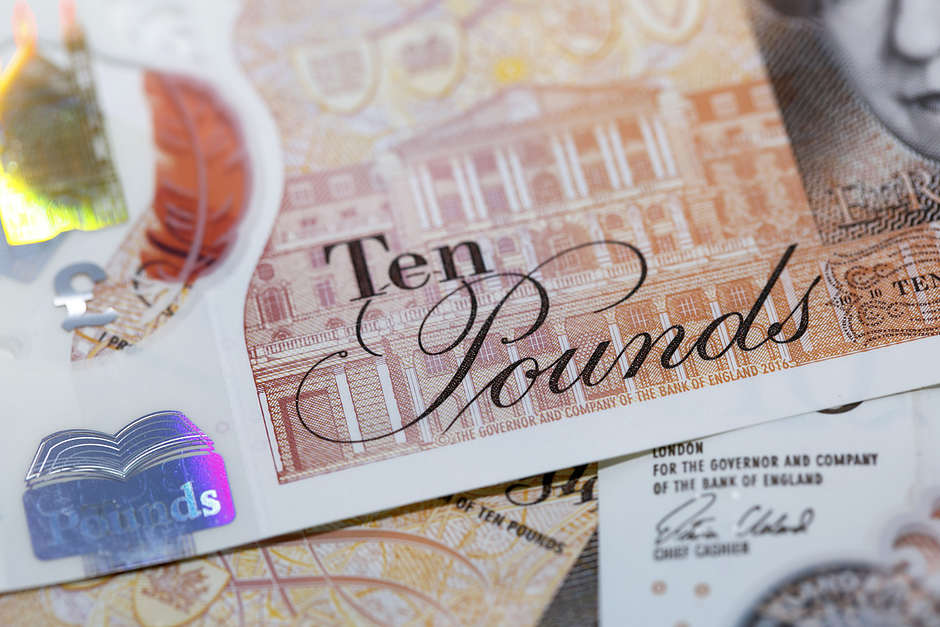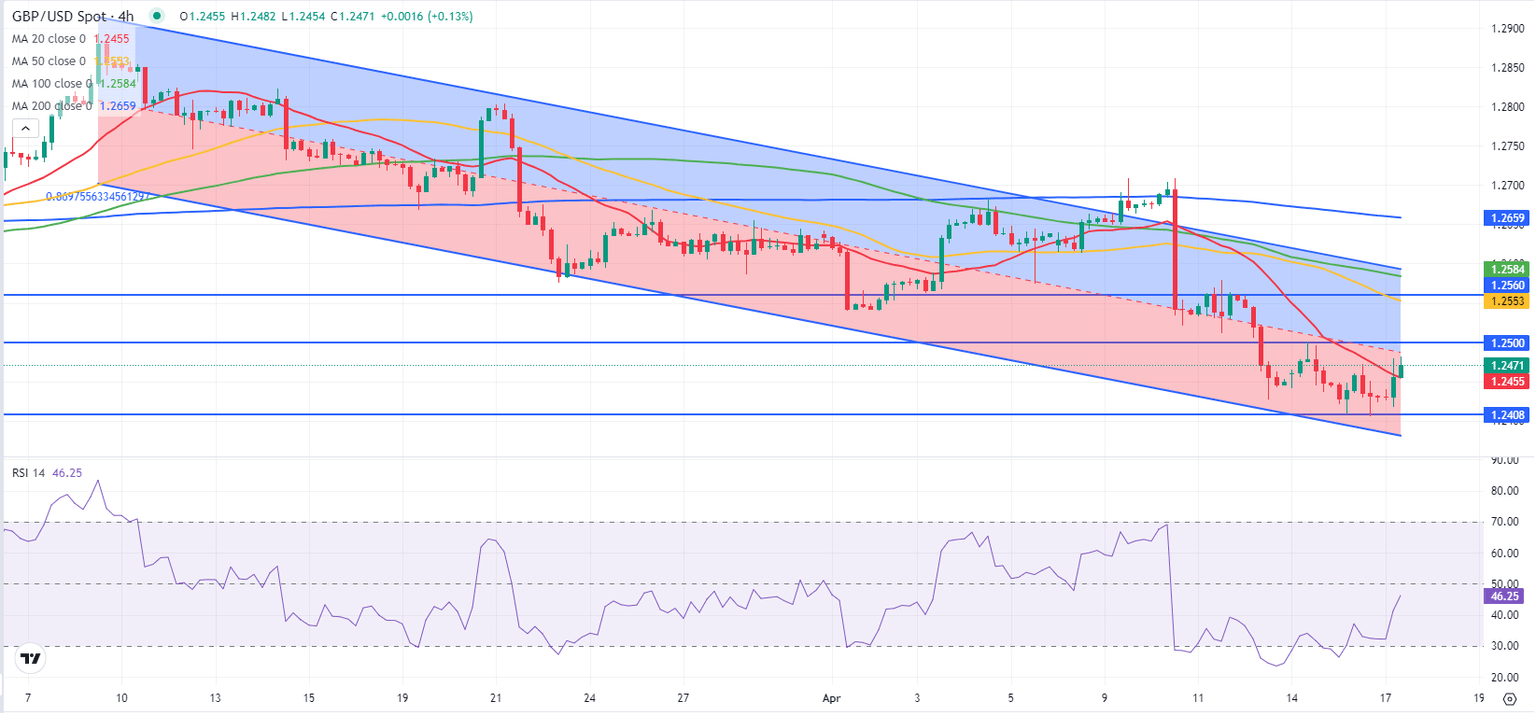GBP/USD Forecast: Pound Sterling could face stiff resistance at 1.2500
- GBP/USD gathered recovery momentum in the European session on Wednesday.
- Annual CPI inflation in the UK edged lower to 3.2% in March.
- The pair could encounter strong resistance at 1.2500.

GBP/USD gained traction in the early European session on Wednesday and climbed above 1.2450. The near-term technical outlook points to a buildup of recovery momentum but the pair could face stiff resistance at 1.2500.
The UK's Office for National Statistics (ONS) reported on Wednesday that inflation, as measured by the change in the Consumer Price Index (CPI), declined to 3.2% in March from 3.4% in February. This reading came in above the market expectation of 3.1%. Furthermore, the core CPI, which excludes volatile food and energy prices, rose 4.2% in the same period, compared to analysts' estimate of 4.1%. With the immediate reaction to these readings, Pound Sterling gathered strength against its rivals.
Pound Sterling price today
The table below shows the percentage change of Pound Sterling (GBP) against listed major currencies today. Pound Sterling was the weakest against the Swiss Franc.
| USD | EUR | GBP | CAD | AUD | JPY | NZD | CHF | |
| USD | -0.17% | -0.34% | -0.08% | -0.17% | -0.08% | -0.24% | -0.26% | |
| EUR | 0.18% | -0.16% | 0.10% | 0.00% | 0.07% | -0.09% | -0.07% | |
| GBP | 0.32% | 0.15% | 0.26% | 0.16% | 0.23% | 0.07% | 0.06% | |
| CAD | 0.07% | -0.10% | -0.27% | -0.11% | -0.03% | -0.19% | -0.19% | |
| AUD | 0.16% | 0.00% | -0.15% | 0.11% | 0.07% | -0.08% | -0.08% | |
| JPY | 0.09% | -0.08% | -0.25% | 0.03% | -0.13% | -0.17% | -0.16% | |
| NZD | 0.26% | 0.06% | -0.08% | 0.17% | 0.07% | 0.15% | -0.02% | |
| CHF | 0.25% | 0.08% | -0.07% | 0.18% | 0.08% | 0.15% | 0.00% |
The heat map shows percentage changes of major currencies against each other. The base currency is picked from the left column, while the quote currency is picked from the top row. For example, if you pick the Euro from the left column and move along the horizontal line to the Japanese Yen, the percentage change displayed in the box will represent EUR (base)/JPY (quote).
In the meantime, the US Dollar struggles to find demand and helps GBP/USD edge higher as market mood improves midweek. The UK's FTSE 100 Index is rising more than 0.5% on the day and US stock index futures are up between 0.2% and 0.4%.
In the absence of high-tier data releases from the US, GBP/USD could hold its ground in case risk flows continue to dominate the action in financial markets.
Investors will also keep a close eye on the developments surrounding the Iran-Israel conflict. Israel is expected to hold a cabinet meeting to decide how they will respond to Iran's retaliatory attack over the weekend. If geopolitical tensions escalate further in the Middle East, the USD could regather its strength and limit GBP/USD's upside.
GBP/USD Technical Analysis
GBP/USD rose above the 20-period Simple Moving Average (SMA) on the 4-hour chart for the first time in a week and the Relative Strength Index advanced toward 50, reflecting a buildup of recovery momentum.
On the upside, 1.2500 (former support, psychological level) aligns as immediate resistance. If GBP/USD manages to flip that level into support, it could extend its recovery toward 1.2560 (static level) and 1.2580 (200-day SMA, upper limit of the descending channel).
First support is located at 1.2400 (psychological level, static level) ahead of 1.2380 (lower limit of the descending channel).
Pound Sterling FAQs
The Pound Sterling (GBP) is the oldest currency in the world (886 AD) and the official currency of the United Kingdom. It is the fourth most traded unit for foreign exchange (FX) in the world, accounting for 12% of all transactions, averaging $630 billion a day, according to 2022 data. Its key trading pairs are GBP/USD, aka ‘Cable’, which accounts for 11% of FX, GBP/JPY, or the ‘Dragon’ as it is known by traders (3%), and EUR/GBP (2%). The Pound Sterling is issued by the Bank of England (BoE).
The single most important factor influencing the value of the Pound Sterling is monetary policy decided by the Bank of England. The BoE bases its decisions on whether it has achieved its primary goal of “price stability” – a steady inflation rate of around 2%. Its primary tool for achieving this is the adjustment of interest rates. When inflation is too high, the BoE will try to rein it in by raising interest rates, making it more expensive for people and businesses to access credit. This is generally positive for GBP, as higher interest rates make the UK a more attractive place for global investors to park their money. When inflation falls too low it is a sign economic growth is slowing. In this scenario, the BoE will consider lowering interest rates to cheapen credit so businesses will borrow more to invest in growth-generating projects.
Data releases gauge the health of the economy and can impact the value of the Pound Sterling. Indicators such as GDP, Manufacturing and Services PMIs, and employment can all influence the direction of the GBP. A strong economy is good for Sterling. Not only does it attract more foreign investment but it may encourage the BoE to put up interest rates, which will directly strengthen GBP. Otherwise, if economic data is weak, the Pound Sterling is likely to fall.
Another significant data release for the Pound Sterling is the Trade Balance. This indicator measures the difference between what a country earns from its exports and what it spends on imports over a given period. If a country produces highly sought-after exports, its currency will benefit purely from the extra demand created from foreign buyers seeking to purchase these goods. Therefore, a positive net Trade Balance strengthens a currency and vice versa for a negative balance.
Premium
You have reached your limit of 3 free articles for this month.
Start your subscription and get access to all our original articles.
Author

Eren Sengezer
FXStreet
As an economist at heart, Eren Sengezer specializes in the assessment of the short-term and long-term impacts of macroeconomic data, central bank policies and political developments on financial assets.


















